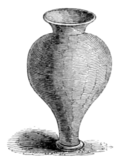stone hollowed out. The latter was found 3 feet under the surface, and contained two glass vases, one with handles; between them lay a pair of leather shoes, ornamented with a cut hexagonal pattern, and gold wire, apparently of Byzantine workmanship. Round it were found traces of red Roman ware, and portions of a wooden box[1]. These discoveries were made close to the Watling-street Road, at the station, conjectured to be Vagniacæ.
In October, 1794, a square cist was found at Ashby Puerorum, Lincolnshire, of which an account was communicated to the Society of Antiquaries by Sir Joseph Banks[2]. The lid lay three feet below the surface; it fitted the sides neatly, and projected slightly over their edges. This cist was formed of the freestone which is found in abundance on Lincoln heath: it was squared and dressed with much care and precision; and measured externally 16 in. square, and 812 in. high; the cavity within measured 12 in. every way. It contained an elegant vase of strong greenish-coloured glass, well manufactured: its dimensions were, height, 7 in.; diameter of the widest part, 7 in.; diameter of the mouth, 4 in. This vessel was nearly filled with fragments of burned bones, and amongst them were portions of a small unguent vase of very thin glass. No highway is known to have passed near the spot; the nearest Roman station is Horncastle, (Banovallum, according to Stukeley,) about five miles distant.
A coffin of rectangular shape, with a skeleton, and three glass vessels, of different shapes, standing in it, was also found near St. Alban's[3]; and another with red Roman ware, and a skeleton, was found in a crypt at York[4]. In 1765 a glass vase, similar to the one found at Harpenden, but without any handle, was discovered at King's Mead, about half a mile from Cirencester, wrapped in lead, and deposited in a stone hollowed out to receive it[5].
The Harpenden cist contained five vases; in the centre was placed a præfericulum, formed of pale green-coloured glass, and of a shape not peculiarly adapted to the purpose of inter-

